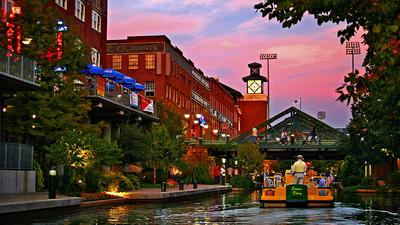February 22, 2014
OKLAHOMA CITY — Oklahoma traces its contemporary history to pioneers who populated the prairies. Now, new urban pioneers are repopulating the capital, Oklahoma City, as restaurateurs re-imagine landmark buildings and create new communities around them.
They could hardly have come at a better time: The local economy is booming, and Forbes ranks OKC as the nation's eighth-fastest-growing city, thanks to thriving oil, gas and wind-power sectors as well as fracking.
It turned out to be an unexpected adventure in food, history and architecture.
I started in Bricktown, just east of OKC's compact downtown. Twenty-five years ago, these 45 city blocks of onetime warehouses sat mostly abandoned after the freight trains relocated. Now, Bricktown's music venues and clubs anchor the local night life, and hotels, restaurants and shops lend a low-key bustle during the day.
A 40-minute water-taxi ride ($9.50) on a canal built on a former street through Bricktown wends its way past mosaic murals and life-size bronze statues of rough-and-ready pioneers on horseback and wagon train. On my trip, the captain, a chatty young feller, narrated local sights, history and lore with patter not unlike that of Mark Twain.
Other big players have filled in Bricktown too: Chickasaw Bricktown Ballpark, home of the Houston Astros' triple-A farm team, the Oklahoma RedHawks; I Love this Bar & Grill, owned by Oklahoma-born country music star Toby Keith; and a branch of Sonic, Oklahoma's own drive-in burger chain. But it was the restaurants lining the canal that started it all and that store the local soul.
I stopped for lunch at one of the first, Nonna's Euro-American Ristorante & Bar, in a former 22,000-square-foot warehouse, with food that can feel almost as big: beef Stroganoff, Nonna's Favorite (meatballs over spaghetti with marinara and alfredo sauces), and giant cookies and strawberry shortcake for dessert. With entrees topping out at $15, it's a good value. I was inspired to hunt for more.
Next stop was Automobile Alley, just north of the downtown core, an eight-block-long stretch where restaurants, digital media and art and design studios have rejuvenated abandoned Art Deco- and Bauhaus-inspired car dealerships from as far back as the 1920s.
OKC is famous for livestock, and Red PrimeSteak is one of the top steakhouses in town. Behind the stately façade of a former Buick showroom — still sporting the original logo — is a futuristic world that the building's original occupants could scarcely have imagined: Long streaks of red neon imitate taillights, and the former auto turntable is now a private dining room. Besides steaks and cocktails, Red PrimeSteak serves cocoa-cayenne-dusted scallops and classic Southern fried chicken, at L.A.-style prices.
The walk up Broadway Avenue, Automobile Alley's main drag, took me to shops such as Rawhide, for Western clothing and accessories, and Plenty Mercantile, for handcrafted, back-to-nature gifts as well as crafts made by indigenous peoples. Coffee Slingers, once an auto repair shop, is now a cheery, airy coffee bar with its own roasting operation.
From LA Times: Link

 RSS Feed
RSS Feed
